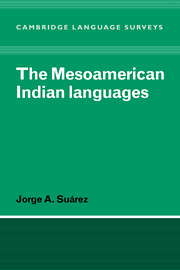Book contents
- Frontmatter
- Contents
- List of illustrations
- List of tables
- Preface
- Notational conventions
- Map 1 Present-day distribution of Mesoamerican Indian languages
- Table 1 Classification of Mesoamerican Indian languages and index to map 1
- 1 The study of Mesoamerican Indian languages
- 2 Dialects, languages and linguistic families
- 3 Phonology I
- 4 Phonology II
- 5 Morphology I
- 6 Morphology II
- 7 Syntax I
- 8 Syntax II
- 9 Preconquest literary traditions
- 10 The prehistory of Mesoamerican Indian languages
- 11 Indian languages after the conquest
- Appendix: Sources for sentences quoted in chapters 7 and 8
- References
- Language index
- Subject index
- Frontmatter
- Contents
- List of illustrations
- List of tables
- Preface
- Notational conventions
- Map 1 Present-day distribution of Mesoamerican Indian languages
- Table 1 Classification of Mesoamerican Indian languages and index to map 1
- 1 The study of Mesoamerican Indian languages
- 2 Dialects, languages and linguistic families
- 3 Phonology I
- 4 Phonology II
- 5 Morphology I
- 6 Morphology II
- 7 Syntax I
- 8 Syntax II
- 9 Preconquest literary traditions
- 10 The prehistory of Mesoamerican Indian languages
- 11 Indian languages after the conquest
- Appendix: Sources for sentences quoted in chapters 7 and 8
- References
- Language index
- Subject index
Summary
Categories in verbs
In chapter 5 the survey of morphological systems focussed chiefly on the form of words. In the present chapter attention is turned to the categories expressed.
Aspect, tense, mode, negation
The discussion of these categories will focus first of all on those that are expressed obligatorily, and, owing to lack of pertinent information, will mainly be restricted to those categories which are expressed morphologically. The reader should bear in mind, however, that these categories are usually supplemented by particles and/or auxiliary verbs and by adverbs, all of which form part of the total system of a language for expressing these notions.
Some languages have a tense system, others an aspectual one; still others have both aspect and tense, and there are languages in which tense and aspect combine to form a mixed system; it is even fairly common for mode not to form a clearly separate system from tense – aspect.
Simple tense systems are found in Mayan languages. Jacaltec, for instance, marks past and non-past. Past is used for completed events in the past; non-past is used to refer to a present event sensu stricto, to a habitual or repetitive event, to a present event that started in the past (i.e. I have been doing … for X time already), to events contemporaneous with other past or future events (i.e. (I did/will do something) while doing…), and, in combination with a suffix which has other values, it refers to future events.
- Type
- Chapter
- Information
- The Mesoamerican Indian Languages , pp. 71 - 92Publisher: Cambridge University PressPrint publication year: 1983



